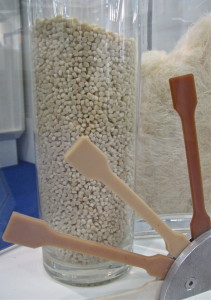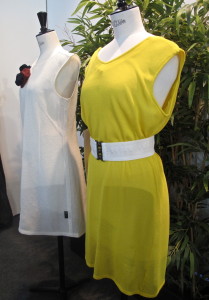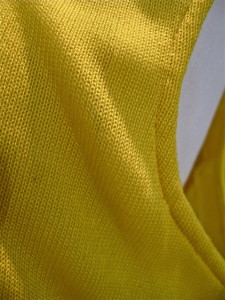
TechTextil at Messe Frankfurt in May hosted 1,662 exhibitors showing materials and products across the large spectrum of markets in the textile world. Messe Frankfurt Monitor APP was introduced to help visitors navigate. The exhibits were diverse, ranging from fibers and yarns to robot-assisted production processes. Three strong themes emerged: performance with comfort, sustainability and TechnoNaturals.
Performance with comfort
The Swiss manufacturer Schoeller Technologies AG showed examples of many of their innovative technologies such as ecorepel®, energear™ and NanoSphere®. Solar+ builds on the success of the company’s coldblack®, which helps to regulate the temperature of black fabrics to keep them at a cool temperature. Solar+ works by helping fabrics of any colour to attract and store more solar heat.

e3+ Protection Plus provides water and wind protection for the wearer using membrane technology. The three-layer laminate uses a hydrophilic polyurethane membrane, and the range includes both elastic and nonelastic options for greater comfort coupled with performance. Both materials are intended for applications in apparel, which is of particular interest in the sports and leisurewear market where Schoeller is positioned strongly at the high end.
Spacer fabrics were shown by a number of companies including two British manufacturers: Heathcoat Fabrics and Palmhive Technical Textiles Ltd. Heathcoat showed 3D knitted spacer fabrics that introduced COOLMAX® for temperature control and added comfort.
Palmhives spacer fabrics included digitally printed options and a wider array of patterned structures, often with color highlights for emphasis. The aesthetics of this group of performance materials is becoming increasingly important and the development in the ranges shown by these and other manufacturers reflected this market move.

Wellman International Ltd. was one of the few exhibitors from Ireland. The company manufactures sustainable polyester fabrics from post-consumer PET bottles. Their products this year included Cirrus, a modified polymer that draws vapor away from the body to create a comfortable microclimate for the wearer. It operates on the principle of drawing the water vapor from a high-pressure microclimate to a low-pressure one. It’s used for sports and fitness applications, such as a liner for sport shoes and in ski wear.
Devan Chemicals NV exhibited textiles that combine performance, comfort and environmental concerns. Their products include Thermic for temperature control, Aegis anti-microbial fabric, Eco-Flam halogen-free flame retardant materials and Insecta offering protection against insects. Insecta uses micro-encapsulation where a synthetic pyrethroid insecticide is placed inside a reactive capsule which once broken, repels mosquitos and other insects. It is produced both in a fragrance and fragrance-free form for applications in clothing and bedding.

Sustainability
Smart Textiles is part of the Swedish School of Textiles undertaking research and development in the field across disciplines such as automotive, medical and apparel. Two garments included in this year’s show considered new approaches to creating sustainable clothing. A white dress was the result of a collaboration with the forestry industry using biotechnology to produce a 100% paper yarn from sustainable resources. A yellow dress exhibited alongside showed the result of recycling denim jeans to produce 100% recycled cotton yarn. Working with Re:newcell, the process takes textiles with a high cellulose content, dissolving it to a pulp to be used in conventional textile manufacturing. It is designed to eliminate the need for harmful chemicals in the recycling process and be low cost.

Qmilch Deutschland GmbH produce Qmilk from casein derived from spoiled milk that cannot be used in the food chain. The fiber is naturally flame retardant, is anti-bacterial and temperature regulating with good tactile properties. The fiber is produced in various forms that include staple lengths and multifilaments, and it can be yarn-, piece- or spun-dyed. Although Qmilch looking to expand and refine their production process to reduce carbon footprint further, the yarn is being produced in quantity now.
TechnoNaturals
Natural materials with enhanced performance characteristics, TechnoNaturals, began to appear at the previous TectTextil and were showing this year in a more developed form. In some instances they utilize a by-product that would otherwise become waste. One example of this was Corkshell™ from Schoeller Technologies AG.
Using a pulverised FSC-certified cork from the wine cork production process, a two-layer fabric construction uses fabric as the inside layer of the material for thermal insulation. A three-layer construction sees a layer of cork sandwiched between two layers of textiles, again providing a warm, breathable component coupled with water and windproof properties provided by the fabric. Inherently elastic, the textiles produced in this range have both two- and four-way stretch capabilities, depending on the textiles that are used.
The second approach to TechnoNaturals originates from the synthetic yarn or fabric and introduces a natural fiber for enhanced aesthetic, tactile and comfort qualities. This is especially important for protective clothing that has to be worn over prolonged periods of time often in extreme environmental conditions.

Inventex Spezialtextilwerek Funke combines wool with Kevlar and polyurethane with ceramic. Israel based manufacturer Nilit Ltd. specializes in high-performance nylon yarns for applications in clothing and intimate apparel. Included in their range this year was NILIT® Heat, which is made using coffee charcoal and provides antibacterial, deodorizing and thermal regulation for the wearer. The company, with LincSpun Yarns Pty Ltd., also produced TrinoMax AQ®, a nylon Aquarius yarn with Merino wool spun around the synthetic core to provide thermo-regulation with wicking and soft tactile qualities, desirable for leisure and fitness applications.
Unexpected absence
The show exhibits were notable for what was there, but also for areas that were absent. Although 3D printing is attracting much attention in all areas from medical devices to whole houses, there was little to see either in TechTextil or in the equipment section that accompanied the show, TexProcess. One manufacturer who had anticipated launching a conductive polymer for 3D printing shortly after the last show admitted that scaling up the process had not proven possible.
This experience was echoed by Anke Domaske, CEO of Qmilch Deutschland GmbH saying that “To scale an invention in production is once again a challenging task”.
Innovation is the starting point, bringing it to market remains a challenge in particular for smaller companies. This makes those that do make it to full production all the more impressive and exciting to see.
Marie O’Mahony is Professor of Materials Art + Design at the Design Faculty, Ontario College of Art + Design University, also Visiting Professor at University of the Arts, London.

 TEXTILES.ORG
TEXTILES.ORG


